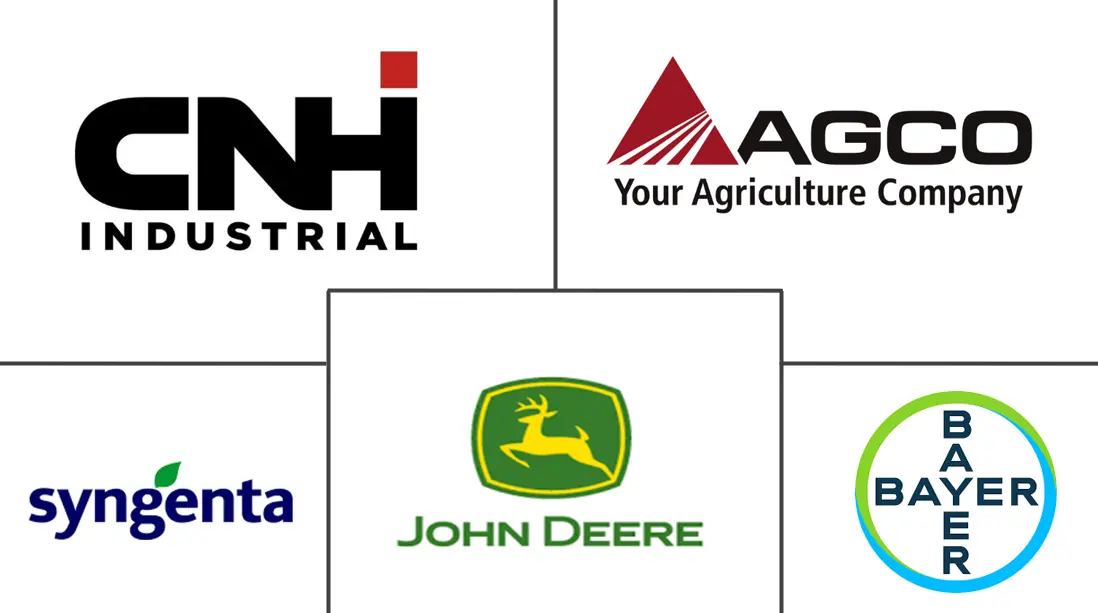Digital Agriculture Market Size and Share
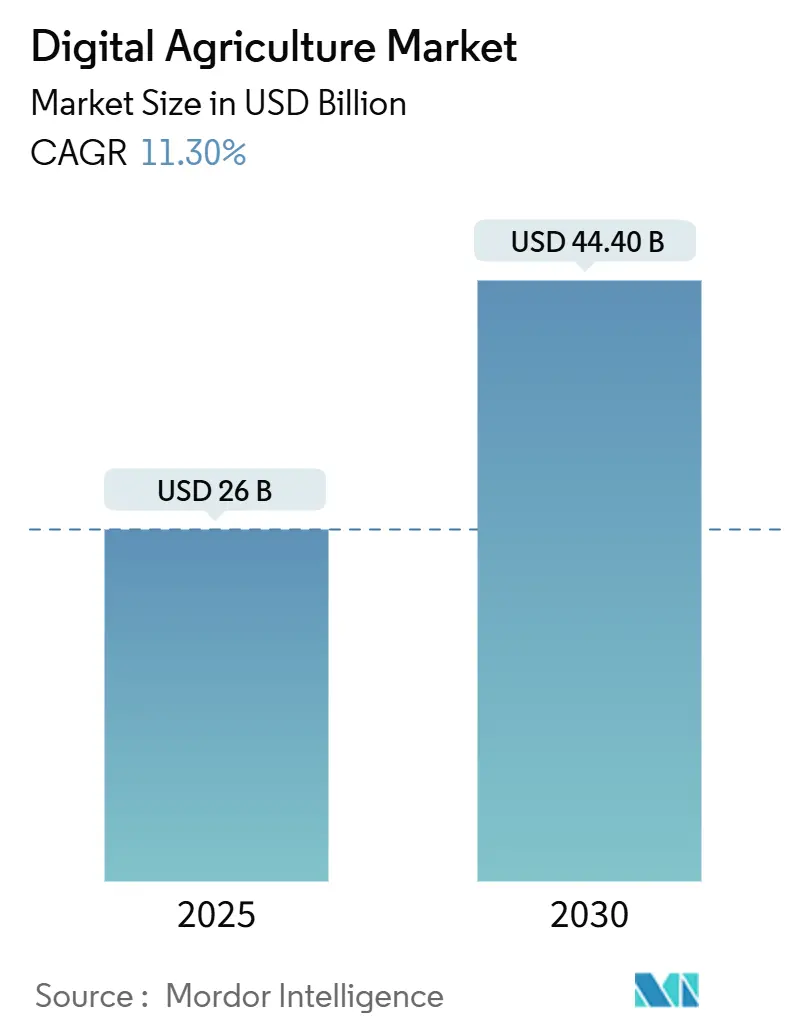
Digital Agriculture Market Analysis by Mordor Intelligence
The digital agriculture market is valued at USD 26 billion in 2025 and is forecast to climb to USD 44.4 billion by 2030, advancing at an 11.3% CAGR. The growth reflects a shift from pilot projects to standard farming infrastructure as lower hardware prices, sizeable government incentives, and mounting pressure to lift global food output by 60% converged. Momentum increased after the United States Department of Agriculture (USDA) disbursed USD 10 billion in Emergency Commodity Assistance in 2025, a package that encouraged producers grappling with volatile input costs to accelerate technology adoption[1]Source: United States Department of Agriculture, “Emergency Commodity Assistance Program,” usda.gov . Additional catalysts include labor shortages, climate adaptation requirements, and stricter sustainability regulations that steer farms toward data-driven practices. Artificial intelligence (AI) tools and precision hardware now integrate more seamlessly, while regional growth patterns show Asia-Pacific expanding fastest at 14% CAGR, North America holding the largest share, and autonomous machinery suppliers repositioning their offerings to match evolving demand.
Key Report Takeaways
- By technology, IoT sensors captured 38% of the digital agriculture market share in 2024, while Artificial Intelligence is projected to post the fastest 22.7% CAGR through 2030.
- By solution, Hardware commanded 47.5% of the digital agriculture market size in 2024; Services are forecast to deliver the highest 18.4% CAGR by 2030.
- By application, Crop Monitoring accounted for 35.2% of the digital agriculture market share in 2024, whereas Drone Analytics is set to grow at a 24.6% CAGR through 2030.
- By farm size, Large-Scale Farms held 44% of the digital agriculture market share in 2024, while Small-Scale Farms below 100 hectares are projected to expand at a 16.5% CAGR through 2030.
- By geography, North America led with 30% of the digital agriculture market share in 2025, while Asia-Pacific followed at 28% and is forecast to record the quickest 14% CAGR, positioning it to overtake North America by 2030.
- By company, the five largest vendors, such as Deere and Company, CNH Industrial, Syngenta Group, AGCO Corporation, and Bayer AG, collectively controlled 56.5% of global revenue in 2024.
Global Digital Agriculture Market Trends and Insights
Drivers Impact Analysis
| Driver | (~) % Impact on CAGR Forecast | Geographic Relevance | Impact Timeline |
|---|---|---|---|
| Rapid adoption of IoT sensors and connectivity | +2.1% | Global, strongest in Asia-Pacific and North America | Medium term (2-4 years) |
| Falling drone hardware prices | +1.8% | Global, notably Asia-Pacific and South America | Short term (≤ 2 years) |
| Government digital-farming subsidies | +1.5% | North America and Europe, emerging in Asia-Pacific | Medium term (2-4 years) |
| Data-driven yield-boost imperatives | +1.7% | Global, critical in food-deficient regions | Long term (≥ 4 years) |
| Carbon-credit monetization platforms | +0.9% | North America and Europe, expanding worldwide | Long term (≥ 4 years) |
| Farm-generated data marketplaces | +0.6% | North America and Europe; limited elsewhere | Long term (≥ 4 years) |
| Source: Mordor Intelligence | |||
Rapid adoption of IoT sensors and connectivity
Sensor prices now sit below historical cost-benefit thresholds, prompting widespread deployment across row-crop and specialty farms. Investment activity has intensified; for instance, a leading European agritech supplier directed USD 1.11 billion into smart-sensor integration in 2024, emphasizing edge-processing chips that extend battery life. Satellite partnerships such as CNH Industrial’s link-up with Intelsat widen rural broadband coverage, starting in Brazil, where only 19% of farmland had high-speed internet in 2024, cnhindustrial.com. Field-level data feeds into cloud dashboards that report soil moisture, crop stress, and micro-climate changes, raising productivity by up to 40%, according to on-farm studies conducted with IBM’s analytics suite. Although network reach is improving, less than one-third of the world’s surface still lacks mobile coverage, creating regional adoption gaps.
Falling drone hardware prices
Multispectral drones that cost over USD 20,000 five years ago now retail below USD 5,000, unlocking the mid-size farm segment. DJI reports more than 300,000 active agricultural units that treated 500 million hectares by late 2024 while cutting water use by 210 million metric tons. Volume manufacturing, sensor standardization, and looser flight rules in Brazil, the United States, and China slash ownership and compliance expenses. Return on investment is compelling where aerial spraying outperforms ground rigs on uneven terrain and in high-value horticulture. Start-ups are layering AI algorithms on drone imagery to automate lettuce thinning and spot-spraying, eliminating manual passes in labor-scarce markets.
Government digital-farming subsidies
Policy backing has shifted from pilot grants to multi-billion-dollar allocations. The USDA earmarked USD 7.7 billion for climate-smart practices in fiscal 2025, channeling USD 5.7 billion from the Inflation Reduction Act toward digital tools that verify sustainable outcomes[2]Source: United States Department of Agriculture Natural Resources Conservation Service, “Inflation Reduction Act Funding for Climate-Smart Practices,” nrcs.usda.gov . The European Union mandates that every member state embed precision farming targets into national plans under its 2023-2027 Common Agricultural Policy [3]Source: European Commission, “Common Agricultural Policy 2023-2027,” ec.europa.eu . India pledged Rs 6,000 crore (USD 720 million) to build farmer-identity rails and sensor platforms that link every smallholder to verified data services. Such subsidies not only defray capital costs but also create regulatory certainty for suppliers developing long-lifecycle equipment.
Data-driven yield-boost imperatives
Global food production must rise 60% by 2050, yet arable land growth is flat. Cloud-based suites such as Microsoft’s AgPilot let producers blend satellite imagery, weather forecasts, and soil probes to fine-tune seeding, fertilization, and irrigation. Syngenta’s Cropwise AI provides seed prescriptions calibrated to micro-zone soil profiles, lifting profitability while meeting sustainability metrics. Bayer’s E.L.Y. generative AI model raises agronomist response accuracy by 40%, saving four hours a week per user. These precision insights shrink input waste and improve traceability, strengthening the economic case for accelerated digital adoption.
Restraints Impact Analysis
| Restraint | (~) % Impact on CAGR Forecast | Geographic Relevance | Impact Timeline |
|---|---|---|---|
| Fragmented land holdings in developing economies | -1.4% | Asia-Pacific, Africa, and parts of South America | Long term (≥ 4 years) |
| High up-front capital expenditure | -1.8% | Global, most severe in developing regions | Medium term (2-4 years) |
| Limited broadband coverage in rural areas | -1.2% | Global rural zones, acute in Africa and parts of Asia | Medium term (2-4 years) |
| Rising cybersecurity threats to farm networks | -0.9% | Digitally advanced markets | Short term (≤ 2 years) |
| Source: Mordor Intelligence | |||
Fragmented land holdings in developing economies
Small plots under two hectares dominate many Asian and African countries, preventing economies of scale that justify precision equipment investments. India illustrates the issue: average farm size remains under two hectares, and only 25% of producers are confident using digital tools. The government’s Digital Public Infrastructure plan aims to enroll 60 million farmers in a unified registry to enable aggregated service delivery. Cooperative equipment pools and shared-service centers show promise, but cultural barriers and limited digital literacy slow progress. China’s experience with digital platforms facilitating land-transfer agreements reveals one pathway to achieve larger operational blocks without altering ownership patterns.
High up-front capital expenditure
Full-stack digital systems, autonomous tractors, multispectral drones, and IoT networks can exceed USD 150,000 for a 500-hectare operation. Although retrofitting existing machines reduces costs, many medium-sized farms still face multi-year payback horizons. AGCO is prioritizing retrofit kits that upgrade legacy fleets, lowering entry barriers. Equipment-as-a-Service contracts and usage-based pricing offer flexibility, but farmers remain cautious amid volatile commodity prices and interest-rate swings.
Segment Analysis
By Technology: IoT Sensors Lead Market While AI Drives Innovation
IoT captured 38% of the digital agriculture market share in 2024, reflecting its role as the primary gateway for real-time data on soil, crop, and equipment status. Uptake accelerates as hardware prices fall and rural broadband coverage improves; CNH Industrial’s satellite partnership with Intelsat extends connectivity to Brazilian fields where only 19% previously had high-speed internet access. Remote Sensing secured a 32% share through satellite and drone imagery, while GPS-based Guidance Systems accounted for 18.7%. Blockchain and Traceability are rising at a 19.8% CAGR, supported by public programs such as Australia’s USD 5 million AgTrace pilot that tests cross-commodity data protocols[4]Source: Australian Government Department of Agriculture, Fisheries and Forestry, “Agricultural Traceability Initiatives,” Department of Agriculture, agriculture.gov.au.
Artificial Intelligence delivers the fastest 22.7% CAGR, powering predictive tools that lift yields and cut inputs. IBM’s SWAT VEXA unifies decades of soil-water research with generative AI to offer field-specific irrigation advice. Variable Rate Technology grows 13.6% annually, underpinning precise input dosing. Vendors increasingly package sensors, AI, and blockchain inside single dashboards, signaling that integrated platforms—not point solutions—will shape the future digital agriculture market size.
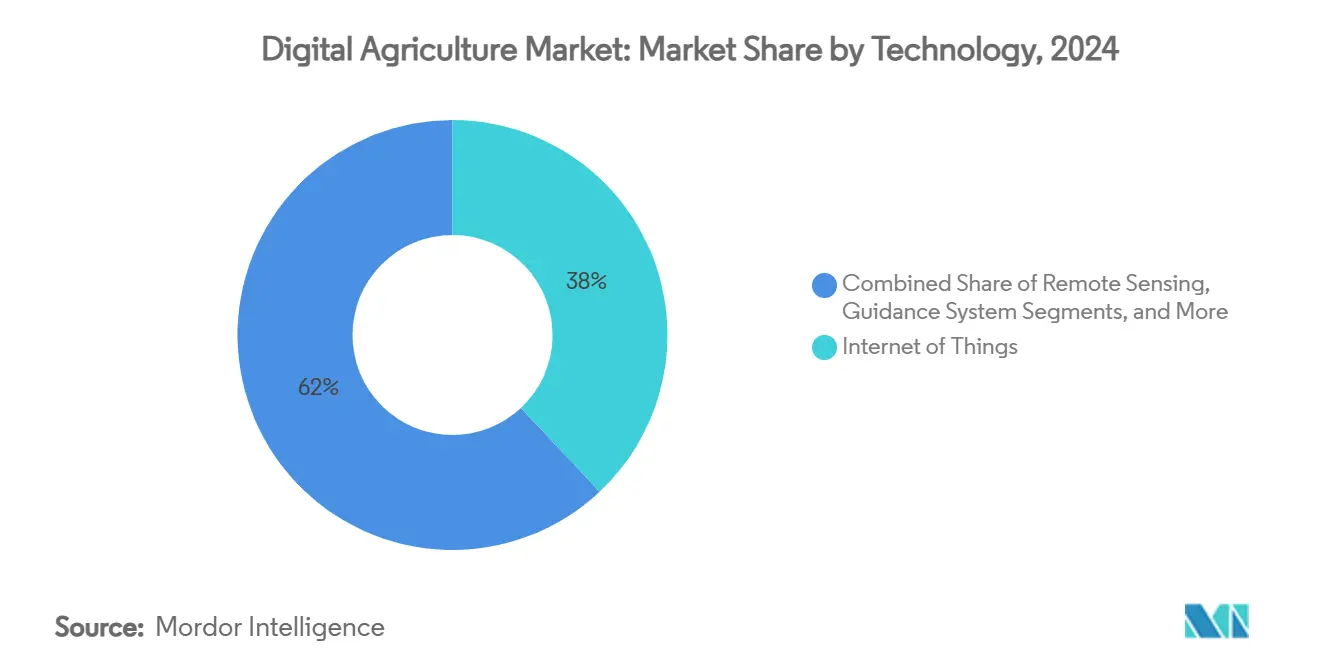
Note: Segment shares of all individual segments available upon report purchase
By Solution: Hardware Dominance Faces Software Challenge
Hardware retained 47.5% of 2024 revenue, underscoring continued demand for capital-intensive machines and sensor arrays. John Deere’s USD 20 billion United States manufacturing pledge highlights sustained investment in autonomous combines and tractors. Software followed with a 42.8% slice as cloud portals translate raw data into task lists, and New Holland’s “Connectivity Included” model removes cellular fees to spur data flow.
Services form the fastest-growing track at an 18.4% CAGR, driven by subscription analytics, equipment health monitoring, and agronomic consulting. AGCO targets a two-fold jump in Precision Tech revenue share by 2030, confirming the shift toward margin-rich service bundles. As Equipment-as-a-Service spreads, farmers increasingly pay for outcomes rather than ownership, redefining value across the digital agriculture market.
By Farm Size: Small Farms Drive Growth Despite Scale Challenges
Large-scale farms above 500 hectares held 44% of the 2024 digital agriculture market share, leveraging economies that justify six-figure tech investments. Medium-scale farms between 100 and 500 hectares controlled a 34% share, with growth ranging from 10.3% to 13.2% CAGR depending on regional subsidy access and retrofit availability.
Small-scale farms under 100 hectares deliver the quickest 16.5% CAGR as cloud apps and cooperative drone pools lower entry barriers. India’s Digital Public Infrastructure aims to register 60 million growers, ensuring even two-hectare plots access shared analytics and equipment. Phytech’s partnerships with irrigation specialists bring plant-level sensing to modest holdings, while AGCO’s retrofit kits give mid-size operators a flexible path to precision adoption. Collectively, these models broaden participation and enlarge the overall digital agriculture market.
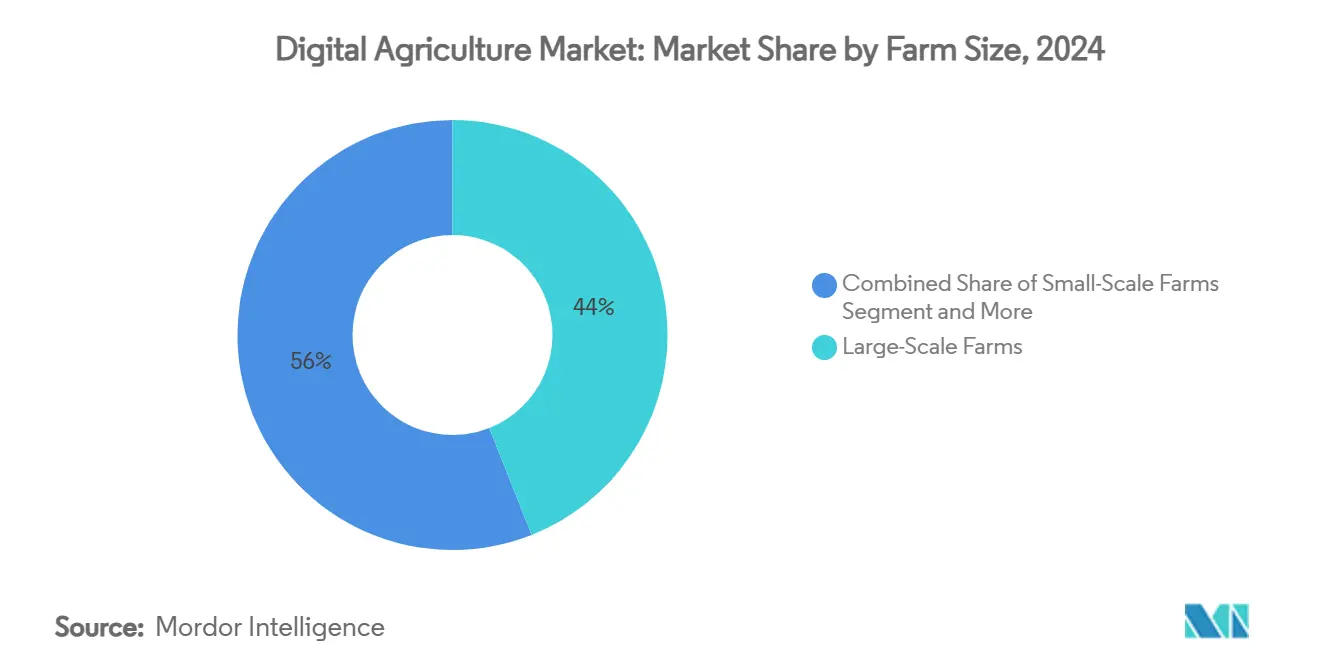
Note: Segment shares of all individual segments available upon report purchase
By Application: Drone Analytics Leads Precision Revolution
Crop Monitoring held 35.2% of the digital agriculture market share in 2024, drawing on multispectral imagery and AI classifiers to spot stress early. Drone Analytics is projected to grow at 24.6% CAGR; DJI’s 300,000-unit fleet has already treated 500 million hectares and cut pesticide use by 47,000 metric tons. Precision Spraying will expand 19.3% a year as vision systems enable 90% herbicide savings.
Yield Mapping accounts for a 28.1% share and is advancing at 14.9% CAGR, buoyed by high-resolution sensors. Soil Monitoring represents 18.8% share, progressing 12.4% annually; the EarthOptics and Pattern Ag merger integrates soil DNA and sensor readings for richer prescriptions. ClimateAi’s hyper-local forecasts, credited with 40% productivity lifts, illustrate how application convergence is reshaping the digital agriculture market size.
Geography Analysis
North America accounted for 30% of the digital agriculture market share in 2025 and is advancing at an 8.7% CAGR. Growth here focuses on optimizing and integrating existing systems because basic tools are already widespread. The USD 10 billion Emergency Commodity Assistance Program boosts upgrades to connected machinery. Canada deepens precision-agriculture penetration through sustainability grants, yet softer equipment sales in 2024, down as much as 25% for major makers, signal short-term caution. The future upside hinges on autonomous fleets and advanced AI rather than first-time sensor installs.
Asia-Pacific holds 28% of the digital agriculture market size and is growing at a 14% CAGR, the fastest worldwide. China’s rural digital economy reached USD 7.74 trillion in 2023, improving factor efficiency and sustainability. India invested Rs 6,000 crore (USD 720 million) to build farmer-registry-linked sensor infrastructure. Japan’s Society 5.0 blends robotics with AI, while Australia’s Food Agility CRC teams with NTT Group to pilot green IoT networks. Land fragmentation and patchy broadband remain headwinds, but satellite links and shared-equipment pools are easing those limits.
Europe maintained a 23.1% market share in 2025 and is set for a 9.4% CAGR, propelled by Common Agricultural Policy mandates that embed digital milestones in subsidy rules. AGCO’s EUR 87 million (USD 92 million) French parts hub underscores supplier commitment. South America controls an 8% share and expands at 12.2% CAGR as Brazil’s modernization and Argentina’s precision-farming push gather pace. The Middle East and Africa own 6% and 4.9% shares, respectively, advancing at 11.6% and 10.9% CAGR; infrastructure gaps still curb near-term scale, but targeted telecom investments are opening new pockets of adoption.
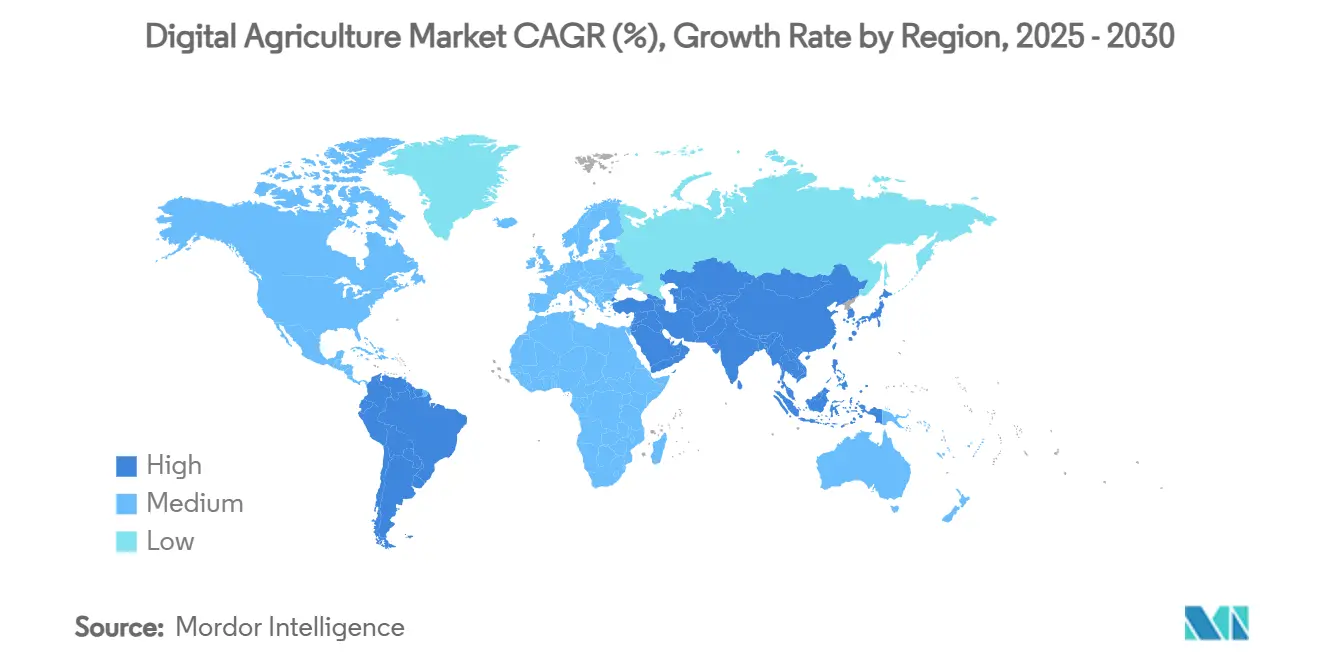
Competitive Landscape
Market concentration is moderate: the top five vendors controlled 56.5% of revenue in 2024. Deere and Company leads with a 22% share, capitalizing on its See and Spray technology and Operations Center platform. CNH Industrial follows at 11% with autonomous and variable-rate tools from its Raven subsidiary. Syngenta Group holds 9.2% through Cropwise decision support, AGCO captures 8.3% via its Fuse ecosystem and retrofit kits, and Bayer sits at 6% on the strength of Climate FieldView and advanced seed scripting.
Consolidation accelerated when AGCO acquired 85% of Trimble Ag for USD 2 billion in February 2025, forming a joint venture to retrofit autonomy onto existing machinery. John Deere committed USD 20 billion to expand United States production and advance full-stack automation, underscoring incumbents’ will to keep technological leadership. Cross-industry alliances multiply: Bayer and Microsoft align on data interoperability, CNH Industrial invested in Brazilian AI firm Bem Agro, and irrigation specialist Phytech teamed with Rivulis and Netafim to embed real-time plant sensors into drip systems.
Disruptors focus on niche pain points. Source.ag applies AI to greenhouse climate control, reporting yield jumps in tomato facilities, while ClimateAi offers risk analytics that integrate weather volatility directly into farm economic models. With service revenue rising faster than equipment sales, incumbents and start-ups alike are pivoting toward subscription platforms that lock in recurring income while lowering farmer entry barriers.
Digital Agriculture Industry Leaders
-
Deere & Company
-
CNH Industrial N.V.
-
AGCO Corporation
-
Bayer AG
-
Syngenta Group
- *Disclaimer: Major Players sorted in no particular order
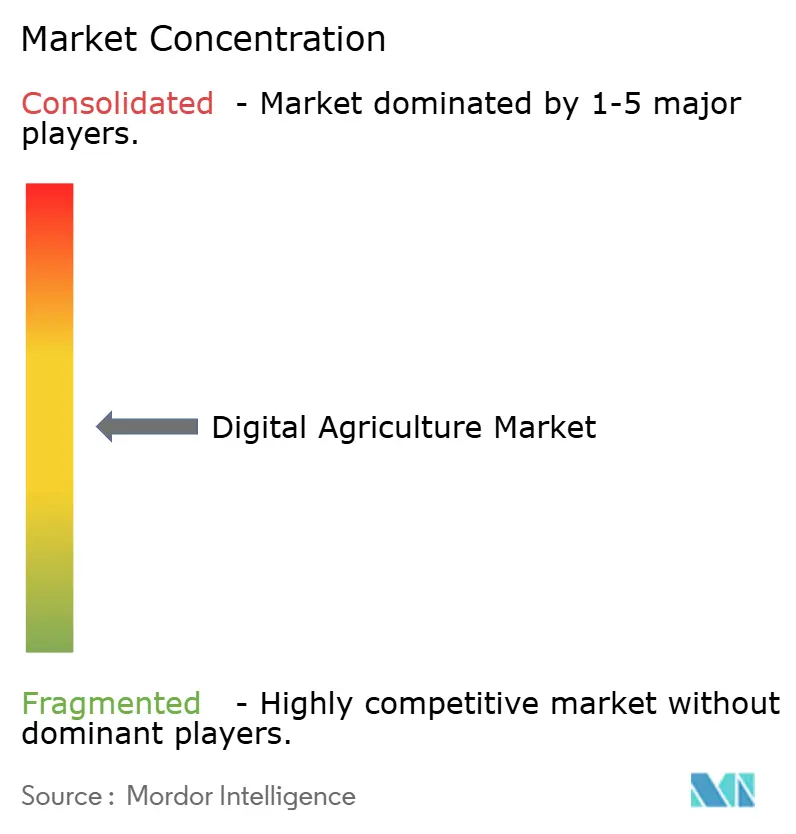
Recent Industry Developments
- May 2025: John Deere pledged USD 20 billion for United States manufacturing expansion over ten years, prioritizing autonomous capabilities.
- April 2025: USDA replaced its USD 3.1 billion Climate-Smart Commodities program with the Advancing Markets for Producers initiative, directing at least 65% of funds straight to farmers.
- February 2025: AGCO closed its USD 2 billion purchase of 85% of Trimble Ag to create an autonomy-focused joint venture.
- November 2024: Syngenta Group rolled out Cropwise AI, adding advanced seed recommendations and predictive modeling.
Research Methodology Framework and Report Scope
Market Definitions and Key Coverage
Our study defines the digital agriculture market as the full suite of hardware, software, and connected services that capture, transmit, analyze, and apply data to crop and livestock operations, beginning with in-field sensing and ending at the farm gate. This includes precision machinery, IoT sensors, remote-sensing drones and satellites, analytics platforms, and advisory applications that help farmers decide when and how to plant, feed, irrigate, and harvest.
Scope exclusion: Activities downstream of the farm gate, such as commodity trading platforms and food-processing software, are excluded from our sizing.
Segmentation Overview
- By Technology
- Guidance Systems
- Remote Sensing
- Variable Rate Technology
- Artificial Intelligence
- Internet of Things
- Blockchain and Traceability
- By Solution
- Hardware
- Software
- Services
- By Application
- Crop Monitoring
- Yield Mapping
- Soil Monitoring
- Weather Tracking
- Precision Spraying
- Drone Analytics
- By Farm Size
- Small-Scale Farms (less than 100 ha)
- Medium-Scale Farms (100-500 ha)
- Large-Scale Farms (more than 500 ha)
- By Geography
- North America
- United States
- Canada
- Mexico
- Rest of North America
- South America
- Brazil
- Argentina
- Rest of South America
- Europe
- Germany
- United Kingdom
- France
- Italy
- Spain
- Russia
- Rest of Europe
- Asia-Pacific
- China
- India
- Japan
- Australia
- South Korea
- Rest of Asia-Pacific
- Middle East
- Saudi Arabia
- United Arab Emirates
- Turkey
- Rest of Middle East
- Africa
- South Africa
- Egypt
- Rest of Africa
- North America
Detailed Research Methodology and Data Validation
Primary Research
Multiple structured interviews were held with agronomists, drone-service operators, regional dealer networks, growers' cooperatives, and public-extension officers across North America, Europe, Asia-Pacific, and Latin America. These discussions tested unit-penetration assumptions, price dispersion, and upgrade cycles, and they fed qualitative weightings that fine-tuned forecast drivers identified during desk work.
Desk Research
Our analysts mapped the addressable technology pool by screening open data from authorities such as the FAO, USDA ERS, Eurostat, and India's National Sample Survey, which quantify cropland, livestock units, and capital spending per hectare. We layered in adoption ratios drawn from the World Bank rural-broadband dashboards and ITU connectivity datasets to ground the reach of connected devices. Financial filings and investor decks of leading farm-equipment makers, sensor providers, and ag-software firms clarified average selling prices, while patent trends from the EPO's digital-agriculture dashboard signaled emerging cost curves. Subscription databases that Mordor licenses, D&B Hoovers for company revenue splits and Dow Jones Factiva for deal flow, helped us validate commercial roll-outs. The sources cited here are illustrative; many additional public and paid references informed the evidence base.
Market-Sizing & Forecasting
A top-down model converts cultivated-area and livestock-head statistics into a potential spending pool, applying technology-specific penetration rates and annual spend per hectare or per animal. Select bottom-up checks, such as drone shipment tallies and sampled farm-management-software subscriptions, validate totals and reveal under-reported pockets, which are subsequently adjusted. Key variables include rural broadband coverage, average drone price trajectory, per-acre variable-rate-technology uptake, government subsidy outlays, and crop-price swings that influence capital budgets. Forecasts run on a multivariate-regression framework where connectivity growth, commodity prices, and subsidy intensity act as leading indicators, with scenario bands reviewed by industry experts before lock-in.
Data Validation & Update Cycle
Outputs face three layers of review: automated variance scans against historical series, peer analyst cross-checks, and a senior analyst sign-off. We refresh every twelve months, triggering interim updates when policy shifts or technology breakthroughs materially alter any core driver.
Why Mordor's Digital Agriculture Baseline Commands Reliability
Published estimates often diverge because providers choose differing start years, bundle adjacent technologies, or translate local prices at outdated exchange rates.
Key gap drivers include (1) Mordor's farm-gate boundary, whereas some studies fold in post-harvest logistics; (2) our use of in-country price audits versus averaged global ASPs; and (3) our annual refresh cadence, while others revise models less frequently.
Benchmark comparison
| Market Size | Anonymized source | Primary gap driver |
|---|---|---|
| 26.0 Bn (2025) | Mordor Intelligence | - |
| 24.2 Bn (2024) | Global Consultancy A | Excludes drone-service revenues and uses 2022 FX rates |
| 22.0 Bn (2023) | Trade Journal B | Bundles only hardware sales and applies a three-year refresh cycle |
These comparisons show that when scope, pricing, and update cadence are fully aligned, Mordor's disciplined triangulation delivers a balanced, transparent baseline that decision-makers can replicate and trust.
Key Questions Answered in the Report
What is the current value of the digital agriculture market?
The digital agriculture market stands at USD 26 billion in 2025.
How fast will the digital agriculture market grow?
Between 2025 and 2030 the market is projected to expand at an 11.3% CAGR, reaching USD 44.4 billion in value.
Which technology segment is advancing the quickest?
Artificial Intelligence will post the fastest 22.7% CAGR through 2030, outpacing all other technology categories.
Which region is projected to see the highest growth?
Asia-Pacific is forecast to lead with a 14% CAGR thanks to sizable investments in China, India, and Japan.
Who are the leading companies?
Deere and Company, CNH Industrial, Syngenta Group, AGCO Corporation, and Bayer AG together control 56.5% of worldwide revenue.
What is the main barrier to adoption for small farms?
High up-front capital expenditure combined with fragmented landholdings makes it hard for smallholders to achieve payback without cooperative or service-based models.
Page last updated on:
